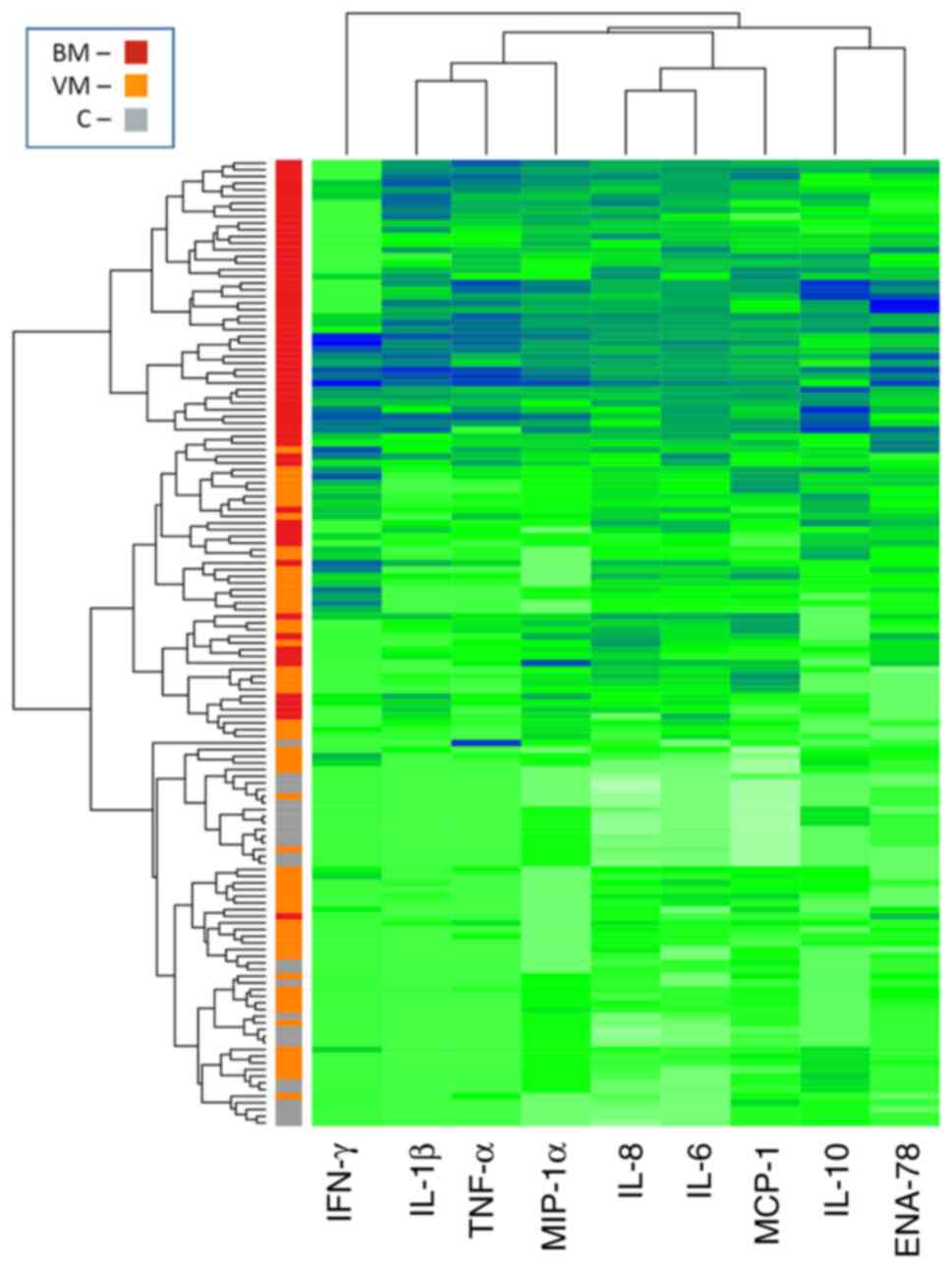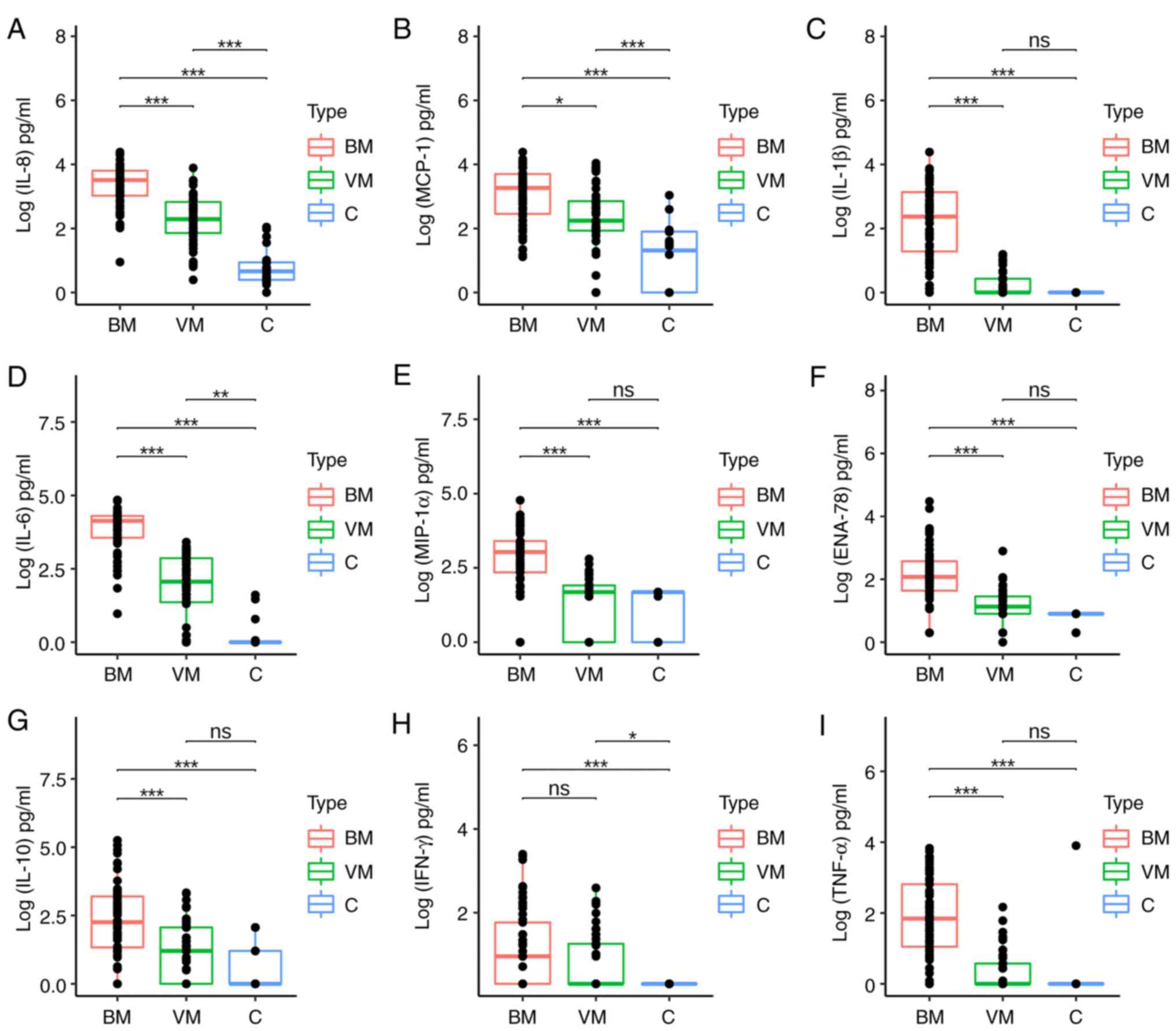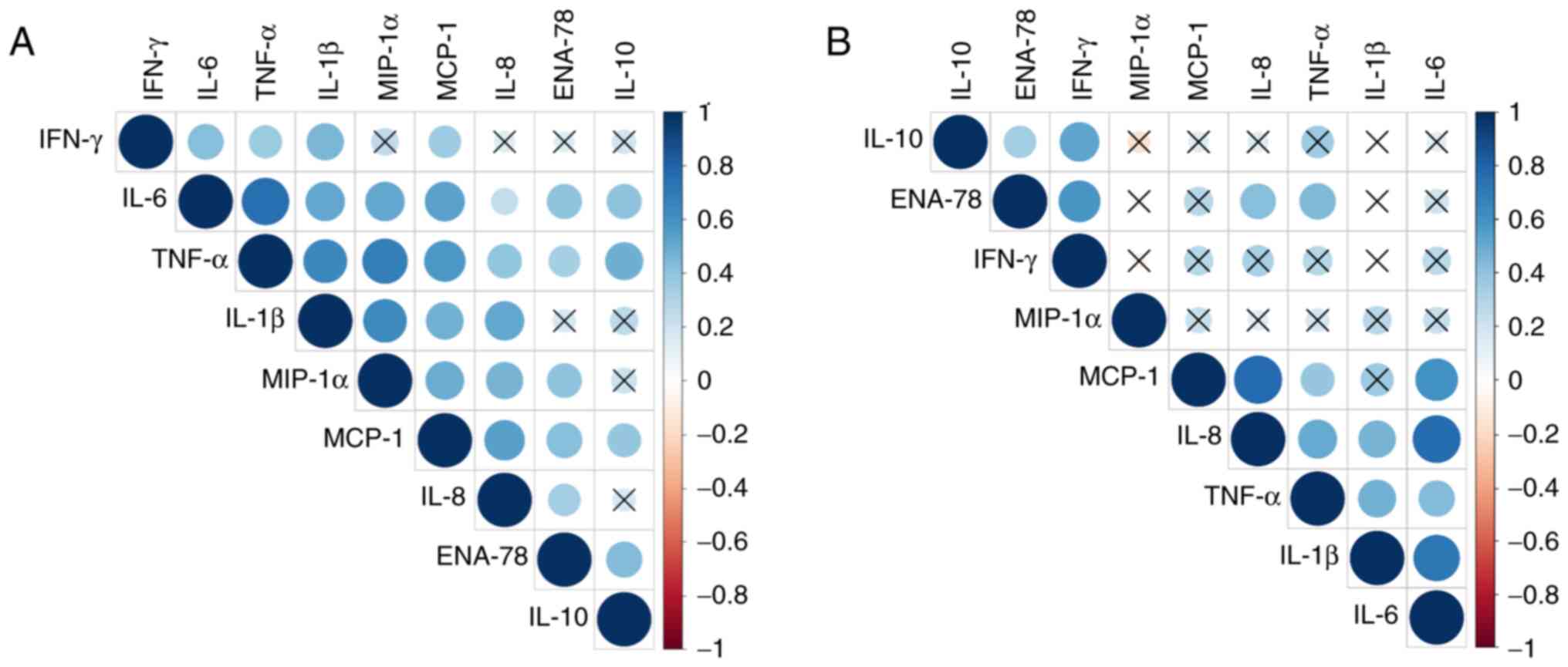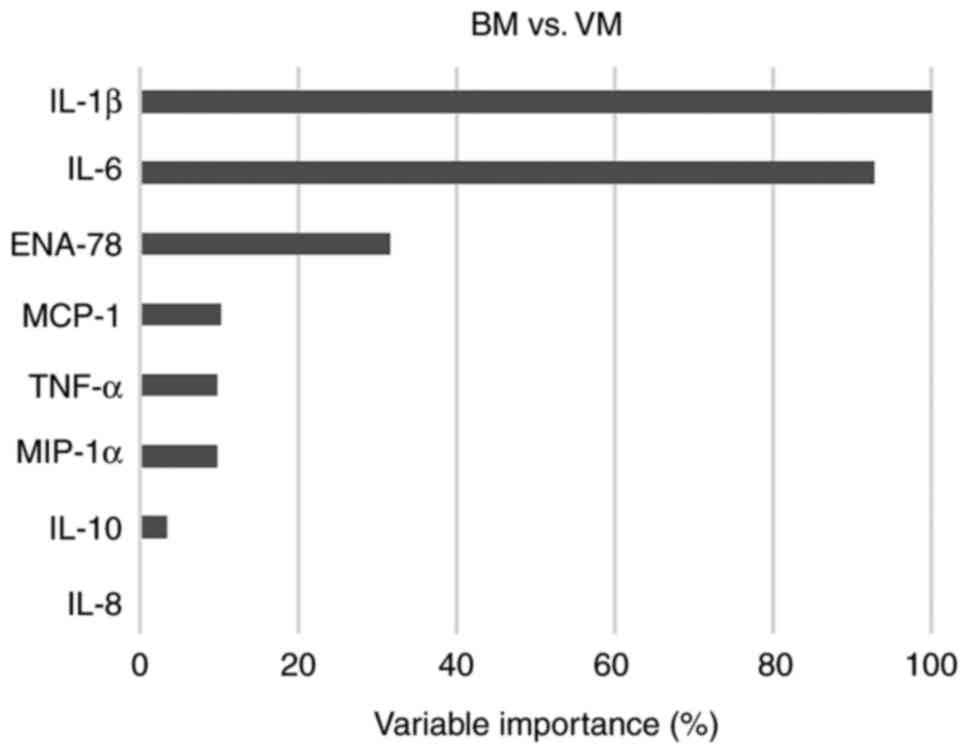|
1
|
García-Hernández P, Prieto B,
Martínez-Morillo E, Rodríguez V and Álvarez FV: Interleukin-6 in
cerebrospinal fluid as a biomarker of acute meningitis. Ann Clin
Biochem. 53:155–163. 2016.PubMed/NCBI View Article : Google Scholar
|
|
2
|
Ai J, Xie Z, Liu G, Chen Z, Yang Y, Li Y,
Chen J, Zheng G and Shen K: Etiology and prognosis of acute viral
encephalitis and meningitis in Chinese children: A multicentre
prospective study. BMC Infect Dis. 17(494)2017.PubMed/NCBI View Article : Google Scholar
|
|
3
|
Mount HR and Boyle SD: Aseptic and
bacterial meningitis: Evaluation, treatment, and prevention. Am Fam
Physician. 96:314–322. 2017.PubMed/NCBI
|
|
4
|
Prasad R, Kapoor R, Srivastava R, Mishra
OP and Singh TB: Cerebrospinal fluid TNF-α, IL-6, and IL-8 in
children with bacterial meningitis. Pediatr Neurol. 50:60–65.
2014.PubMed/NCBI View Article : Google Scholar
|
|
5
|
Sharew A, Bodilsen J, Hansen BR, Nielsen H
and Brandt CT: The cause of death in bacterial meningitis. BMC
Infect Dis. 20(182)2020.PubMed/NCBI View Article : Google Scholar
|
|
6
|
Hsu MH, Hsu JF, Kuo HC, Lai MY, Chiang MC,
Lin YJ, Huang HR, Chu SM and Tsai MH: Neurological complications in
young infants with acute bacterial meningitis. Front Neurol.
9(903)2018.PubMed/NCBI View Article : Google Scholar
|
|
7
|
Zainel A, Mitchell H and Sadarangani M:
Bacterial meningitis in children: Neurological complications,
associated risk factors, and prevention. Microorganisms.
9(535)2021.PubMed/NCBI View Article : Google Scholar
|
|
8
|
van de Beek D, Cabellos C, Dzupova O,
Esposito S, Klein M, Kloek AT, Leib SL, Mourvillier B, Ostergaard
C, Pagliano P, et al: ESCMID guideline: Diagnosis and treatment of
acute bacterial meningitis. Clin Microbiol Infect. 22 (Suppl
3):S37–S62. 2016.PubMed/NCBI View Article : Google Scholar
|
|
9
|
van de Beek D, Brouwer M, Hasbun R, Koedel
U, Whitney CG and Wijdicks E: Community-acquired bacterial
meningitis. Nat Rev Dis Primer. 2(16074)2016.PubMed/NCBI View Article : Google Scholar
|
|
10
|
Torres SD, Kim CY, Das M, Ankam JV, Luche
N, Harmon M, Schorr EM, Glassberg B, Morse SS, Weiss D, et al:
Delays in diagnosis and treatment of bacterial meningitis in NYC:
Retrospective cohort analysis. Neurohospitalist. 12:268–272.
2022.PubMed/NCBI View Article : Google Scholar
|
|
11
|
Brouwer MC, McIntyre P, Prasad K and van
de Beek D: Corticosteroids for acute bacterial meningitis. Cochrane
Database Syst Rev. 2015(CD004405)2015.PubMed/NCBI View Article : Google Scholar
|
|
12
|
Salman O, Procter SR, McGregor C, Paul P,
Hutubessy R, Lawn JE and Jit M: Systematic review on the acute
cost-of-illness of sepsis and meningitis in neonates and infants.
Pediatr Infect Dis J. 39:35–40. 2020.PubMed/NCBI View Article : Google Scholar
|
|
13
|
Liu Q, Gao Y, Zhang B, Sun F, Yang Q, Liu
Y, Wu J, Chen K, Weng X, Zhang W, et al: Cytokine profiles in
cerebrospinal fluid of patients with meningitis at a tertiary
general hospital in China. J Microbiol Immunol Infect. 53:216–224.
2020.PubMed/NCBI View Article : Google Scholar
|
|
14
|
Xu J, Jiang J, Zhang Y and Li W: Cytokine
characteristic of cerebrospinal fluid from children with
enteroviral meningitis compared to bacterial meningitis. J Clin Lab
Anal. 34(e23198)2020.PubMed/NCBI View Article : Google Scholar
|
|
15
|
Jafari M, Mohammadzadeh Jahani P,
Choopanizadeh M, Jamalidoost M, Pourabbas B, Pouladfar G and Kalani
M: Investigating the role of T helper related cytokines in
cerebrospinal fluid for the differential diagnosis of bacterial
meningitis in pre-treated paediatric patients. Biomarkers.
25:171–178. 2020.PubMed/NCBI View Article : Google Scholar
|
|
16
|
Srinivasan L, Kilpatrick L, Shah SS,
Abbasi S and Harris MC: Elevations of novel cytokines in bacterial
meningitis in infants. PLoS One. 13(e0181449)2018.PubMed/NCBI View Article : Google Scholar
|
|
17
|
Lepennetier G, Hracsko Z, Unger M, Van
Griensven M, Grummel V, Krumbholz M, Berthele A, Hemmer B and
Kowarik MC: Cytokine and immune cell profiling in the cerebrospinal
fluid of patients with neuro-inflammatory diseases. J
Neuroinflammation. 16(219)2019.PubMed/NCBI View Article : Google Scholar
|
|
18
|
Kul G, Sencan I, Kul H, Korkmaz N and
Altunay E: The role of cerebrospinal fluid biomarkers in the
diagnosis of post-neurosurgical meningitis. Turk Neurosurg.
30:513–519. 2020.PubMed/NCBI View Article : Google Scholar
|
|
19
|
Müller A, Schramm DB, Kleynhans J, de
Gouveia L, Meiring S, Ramette A, von Gottberg A and Hathaway LJ:
Cytokine response in cerebrospinal fluid of meningitis patients and
outcome associated with pneumococcal serotype. Sci Rep.
11(19920)2021.PubMed/NCBI View Article : Google Scholar
|
|
20
|
Le Guennec L, Coureuil M, Nassif X and
Bourdoulous S: Strategies used by bacterial pathogens to cross the
blood-brain barrier. Cell Microbiol. 22(e13132)2020.PubMed/NCBI View Article : Google Scholar
|
|
21
|
Lee KY, Seol JH, Yi CH and Lee WH:
Cerebrospinal fluid type I interferon and cytokine profiles in
enteroviral meningitis according to the presence or absence of
pleocytosis. Pediatr Neonatol. 62:305–311. 2021.PubMed/NCBI View Article : Google Scholar
|
|
22
|
Perdomo-Celis F, Torres MA, Ostos H,
Gutierrez-Achury J, Molano V, Durán LF, González G and Narváez CF:
Patterns of local and systemic cytokines in bacterial meningitis
and its relation with severity and long-term sequelae. Biomark
Insights. 10:125–131. 2015.PubMed/NCBI View Article : Google Scholar
|
|
23
|
Too LK, Hunt N and Simunovic MP: The role
of inflammation and infection in age-related neurodegenerative
diseases: Lessons from bacterial meningitis applied to alzheimer
disease and age-related macular degeneration. Front Cell Neurosci.
15(635486)2021.PubMed/NCBI View Article : Google Scholar
|
|
24
|
Farmen K, Tofiño-Vian M and Iovino F:
Neuronal damage and neuroinflammation, a bridge between bacterial
meningitis and neurodegenerative diseases. Front Cell Neurosci.
15(680858)2021.PubMed/NCBI View Article : Google Scholar
|
|
25
|
Parthasarathy G and Philipp MT: Review:
Apoptotic mechanisms in bacterial infections of the central nervous
system. Front Immunol. 3(306)2012.PubMed/NCBI View Article : Google Scholar
|
|
26
|
Ramilo O, Sáez-Llorens X, Mertsola J,
Jafari H, Olsen KD, Hansen EJ, Yoshinaga M, Ohkawara S, Nariuchi H
and McCracken GH Jr: Tumor necrosis factor alpha/cachectin and
interleukin 1 beta initiate meningeal inflammation. J Exp Med.
172:497–507. 1990.PubMed/NCBI View Article : Google Scholar
|
|
27
|
Zwijnenburg PJG, de Bie HMA, Roord JJ, van
der Poll T and van Furth AM: Chemotactic activity of CXCL5 in
cerebrospinal fluid of children with bacterial meningitis. J
Neuroimmunol. 145:148–153. 2003.PubMed/NCBI View Article : Google Scholar
|
|
28
|
Coutinho LG, Grandgirard D, Leib SL and
Agnez-Lima LF: Cerebrospinal-fluid cytokine and chemokine profile
in patients with pneumococcal and meningococcal meningitis. BMC
Infect Dis. 13(326)2013.PubMed/NCBI View Article : Google Scholar
|
|
29
|
Geldhoff M, Mook-Kanamori BB, Brouwer MC,
Troost D, Leemans JC, Flavell RA, Van der Ende A, Van der Poll T
and Van de Beek D: Inflammasome activation mediates inflammation
and outcome in humans and mice with pneumococcal meningitis. BMC
Infect Dis. 13(358)2013.PubMed/NCBI View Article : Google Scholar
|
|
30
|
Srinivasan L, Kilpatrick L, Shah SS,
Abbasi S and Harris MC: Cerebrospinal fluid cytokines in the
diagnosis of bacterial meningitis in infants. Pediatr Res.
80:566–572. 2016.PubMed/NCBI View Article : Google Scholar
|
|
31
|
Ye Q, Shao WX, Shang SQ, Shen HQ, Chen XJ,
Tang YM, Yu YL and Mao JH: Clinical value of assessing cytokine
levels for the differential diagnosis of bacterial meningitis in a
pediatric population. Medicine (Baltimore).
95(e3222)2016.PubMed/NCBI View Article : Google Scholar
|
|
32
|
Zheng K, He FB, Liu H and He Q: Genetic
variations of toll-like receptors: Impact on susceptibility,
severity and prognosis of bacterial meningitis. Infect Genet Evol.
93(104984)2021.PubMed/NCBI View Article : Google Scholar
|
|
33
|
Doran KS, Fulde M, Gratz N, Kim BJ, Nau R,
Prasadarao N, Schubert-Unkmeir A, Tuomanen EI and Valentin-Weigand
P: Host-pathogen interactions in bacterial meningitis. Acta
Neuropathol. 131:185–209. 2016.PubMed/NCBI View Article : Google Scholar
|
|
34
|
Belogurov AA Jr, Ivanova OM, Lomakin YA,
Ziganshin RH, Vaskina MI, Knorre VD, Klimova EA, Gabibov AG, Ivanov
VT and Govorun VM: Mediators and biomarkers of inflammation in
meningitis: Cytokine and peptidome profiling of cerebrospinal
fluid. Biochemistry (Mosc). 81:1293–1302. 2016.PubMed/NCBI View Article : Google Scholar
|
|
35
|
Grandgirard D, Gäumann R, Coulibaly B,
Dangy JP, Sie A, Junghanss T, Schudel H, Pluschke G and Leib SL:
The causative pathogen determines the inflammatory profile in
cerebrospinal fluid and outcome in patients with bacterial
meningitis. Mediators Inflamm. 2013(312476)2013.PubMed/NCBI View Article : Google Scholar
|
|
36
|
van Deuren M, Netea MG, Hijmans A,
Demacker PN, Neeleman C, Sauerwein RW, Bartelink AK and van der
Meer JW: Posttranscriptional down-regulation of tumor necrosis
factor-alpha and interleukin-1beta production in acute
meningococcal infections. J Infect Dis. 177:1401–1405.
1998.PubMed/NCBI View
Article : Google Scholar
|
|
37
|
Souza FDS, Freitas NL, Gomes YCP, Torres
RC, Echevarria-Lima J, da Silva-Filho IL, Leite ACCB, de Lima MASD,
da Silva MTT, Araújo AQC and Espíndola OM: Following the clues:
Usefulness of biomarkers of neuroinflammation and neurodegeneration
in the investigation of HTLV-1-associated myelopathy progression.
Front Immunol. 12(737941)2021.PubMed/NCBI View Article : Google Scholar
|
|
38
|
Baumgartner D, Aebi S, Grandgirard D, Leib
SL, Draeger A, Babiychuk E and Hathaway LJ: Clinical Streptococcus
pneumoniae isolates induce differing CXCL8 responses from human
nasopharyngeal epithelial cells which are reduced by liposomes. BMC
Microbiol. 16(154)2016.PubMed/NCBI View Article : Google Scholar
|
|
39
|
Chang YC, Uchiyama S, Varki A and Nizet V:
Leukocyte inflammatory responses provoked by pneumococcal
sialidase. mBio. 3:e00220–11. 2012.PubMed/NCBI View Article : Google Scholar
|
|
40
|
Blackmore S, Hernandez J, Juda M, Ryder E,
Freund GG, Johnson RW and Steelman AJ: Influenza infection triggers
disease in a genetic model of experimental autoimmune
encephalomyelitis. Proc Natl Acad Sci USA. 114:E6107–E6116.
2017.PubMed/NCBI View Article : Google Scholar
|
|
41
|
Haarmann A, Schuhmann MK, Silwedel C,
Monoranu CM, Stoll G and Buttmann M: Human brain endothelial CXCR2
is inflammation-inducible and mediates CXCL5- and CXCL8-triggered
paraendothelial barrier breakdown. Int J Mol Sci.
20(602)2019.PubMed/NCBI View Article : Google Scholar
|
|
42
|
Gaetani L, Bellomo G, Parnetti L, Blennow
K, Zetterberg H and Di Filippo M: Neuroinflammation and Alzheimer's
disease: A machine learning approach to CSF proteomics. Cells.
10(1930)2021.PubMed/NCBI View Article : Google Scholar
|
|
43
|
Whelan CD, Mattsson N, Nagle MW,
Vijayaraghavan S, Hyde C, Janelidze S, Stomrud E, Lee J, Fitz L,
Samad TA, et al: Multiplex proteomics identifies novel CSF and
plasma biomarkers of early Alzheimer's disease. Acta Neuropathol
Commun. 7(169)2019.PubMed/NCBI View Article : Google Scholar
|
|
44
|
Utz JRJ, Crutcher T, Schneider J, Sorgen P
and Whitley CB: Biomarkers of central nervous system inflammation
in infantile and juvenile gangliosidoses. Mol Genet Metab.
114:274–280. 2015.PubMed/NCBI View Article : Google Scholar
|
|
45
|
Sogorb-Esteve A, Swift IJ, Woollacott IOC,
Warren JD, Zetterberg H and Rohrer JD: Differential chemokine
alteration in the variants of primary progressive aphasia-a role
for neuroinflammation. J Neuroinflammation. 18(224)2021.PubMed/NCBI View Article : Google Scholar
|
|
46
|
Liu ZH, Tu PH, Chen NY, Yip PK, Bowes AL,
Lee CC, Chan SH, Kung CC, Wang AY, Wu CT and Lee ST: Raised
proinflammatory cytokine production within cerebrospinal fluid
precedes fever onset in patients with neurosurgery-associated
bacterial meningitis. Crit Care Med. 43:2416–2428. 2015.PubMed/NCBI View Article : Google Scholar
|
|
47
|
Karaba AH, Zhou W, Hsieh LL, Figueroa A,
Massaccesi G, Rothman RE, Fenstermacher KZJ, Sauer L, Shaw-Saliba
K, Blair PW, et al: Differential cytokine signatures of severe
acute respiratory syndrome coronavirus 2 (SARS-CoV-2) and influenza
infection highlight key differences in pathobiology. Clin Infect
Dis. 74:254–262. 2022.PubMed/NCBI View Article : Google Scholar
|
|
48
|
Saharan SS, Nagar P, Creasy KT, Stock EO,
Feng J, Malloy MJ and Kane JP: Machine learning and statistical
approaches for classification of risk of coronary artery disease
using plasma cytokines. BioData Min. 14(26)2021.PubMed/NCBI View Article : Google Scholar
|
|
49
|
Struck NS, Zimmermann M, Krumkamp R,
Lorenz E, Jacobs T, Rieger T, Wurr S, Günther S, Gyau Boahen K,
Marks F, et al: Cytokine profile distinguishes children with
Plasmodium falciparum malaria from those with bacterial blood
stream infections. J Infect Dis. 221:1098–1106. 2020.PubMed/NCBI View Article : Google Scholar
|
|
50
|
Goyal M, Khanna D, Rana PS, Khaibullin T,
Martynova E, Rizvanov AA, Khaiboullina SF and Baranwal M:
Computational intelligence technique for prediction of multiple
sclerosis based on serum cytokines. Front Neurol.
10(781)2019.PubMed/NCBI View Article : Google Scholar
|
|
51
|
Cai F, Zhao Y, Chen Q, Hu Y, Su S and Lu
Y: Serum cytokine analysis reveals predictors of progression from
chronic hepatitis B to liver cirrhosis. Folia Biol (Praha).
67:28–36. 2021.PubMed/NCBI
|
|
52
|
Speiser JL, Miller ME, Tooze J and Ip E: A
comparison of random forest variable selection methods for
classification prediction modeling. Expert Syst Appl. 134:93–101.
2019.PubMed/NCBI View Article : Google Scholar
|


















